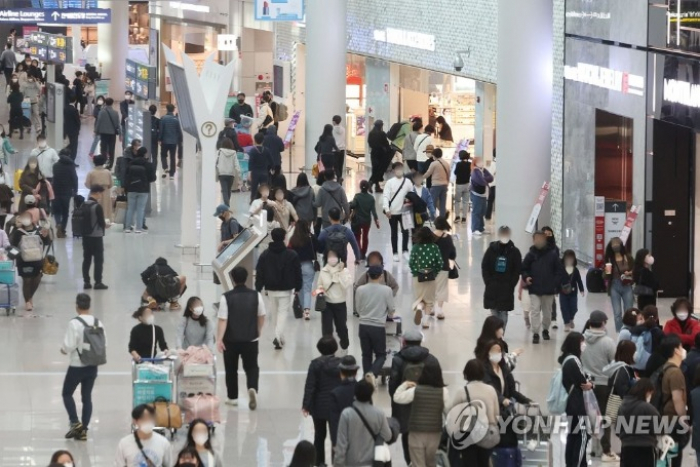Travel & Leisure
Chinese buy cosmetics, Japanese pick groceries in Korea: Survey
Chinese show more conspicuous consumption while Japanese focus on practical value; US visitors love garments the most, KCCI says
By Apr 26, 2023 (Gmt+09:00)
2
Min read
Most Read
LG Chem to sell water filter business to Glenwood PE for $692 million


Kyobo Life poised to buy Japan’s SBI Group-owned savings bank


KT&G eyes overseas M&A after rejecting activist fund's offer


StockX in merger talks with Naver’s online reseller Kream


Mirae Asset to be named Korea Post’s core real estate fund operator



Foreign visitors to South Korea show different purchasing preferences by nationality, a survey found. A majority of Chinese travelers' top picks are cosmetics and perfume, while Japanese tourists love grocery shopping and US visitors buy clothes and leather goods the most, the survey found.
The Korea Chamber of Commerce and Industry (KCCI) surveyed the shopping preferences of 400 foreign visitors departing Korea between March 14 and April 9 and released its findins on Wednesday.
For Asian tourists, cosmetics topped their shopping list, scoring 38.5%. Some 39.6% of both US and European visitors chose clothes & leather goods, such as bags, wallets and belts, as their favorite Korean products.
By country, travelers from China loved Korean cosmetics and perfume the most – 75.8% of them purchased such products. For Japanese visitors, groceries topped their shopping list with 41.9%; some 43.4% of US visitors spent money on Korean clothes & leather products.
The survey respondents spent an average of $968 on shopping while traveling in Korea. Asian tourists used $1,038 on average per person, more than US visitors’ $913 and Europeans’ $870.
Chinese are the largest shoppers, spending $1,546 on average. On consumption criteria, brand power was the most important factor for 35.5% of Chinese visitors. Japanese valued characteristics that represent Korea the most, while 39.6% of US tourists selected quality as the most critical factor.
| China | Japan | US | |
| 1 | Cosmetics, perfume (75.8%) | Groceries (41.9%) | Clothes, leather goods (43.4%) |
| 2 | Clothes, leather goods (19.4%) | Cosmetics, perfume (32.4%) | Cosmetics, perfume (28.3%) |
| 3 | Grocery (3.2%) | Clothes, leather goods (20.3%) | Grocery (20.8%) |
| 4 | Electronic products (1.6%) | Korean cultural products (2.7%) / Dietary supplements (2.7%) | Electronic products (3.8%) |
| 5 | Korean cultural products (1.9%) / Dietary supplements (1.9%) | ||
| Foreign visitors' purchasing preferences in Korea (Courtesy of KCCI) | |||
Foreign visitors’ favorite shopping destinations also differed by the country they came from.
In questions offering more than one choice, Chinese tourists picked department stores and city duty-free shops as the best places, which respectively scored 87.1% and 85.5%. Cultural and shopping centers ranked third with 72.6%.
Japanese picked convenience stores as their favorite shopping destination, which won 86.5% of the votes. Smaller shops and big-box stores followed with 52.7% and 51.4%, respectively.
For US visitors, convenience stores and department stores topped the list, each with 62.3%. About 59% counted traditional markets among their favorite shopping destinations.
As their living standards have improved, Chinese tourists’ consumption has become more conspicuous with high-end brands at department stores and duty-free shops, the report said. Japanese visitors, who are more focused on practical value, look for Korean characteristics and reasonable prices when shopping, it added.
About 90% of the respondents were happy with their shopping experience in Korea. Language and communication topped the issues to be improved for better experiences – some 84% of Chinese tourists found communication uncomfortable, compared with 51% of visitors from the US.
Write to Ye-Rin Choi at rambutan@hankyung.com
Jihyun Kim edited this article.
More to Read
-
 Business & PoliticsS.Korea's medical tourists rebound to 50% of pre-pandemic levels
Business & PoliticsS.Korea's medical tourists rebound to 50% of pre-pandemic levelsApr 24, 2023 (Gmt+09:00)
1 Min read -
 Travel & LeisureSeoul reclaims spot as Japanese tourists' top destination after 11 yrs: HIS
Travel & LeisureSeoul reclaims spot as Japanese tourists' top destination after 11 yrs: HISNov 28, 2022 (Gmt+09:00)
1 Min read -
 EntertainmentSeoul to lure visitors with themed tours, video featuring BTS
EntertainmentSeoul to lure visitors with themed tours, video featuring BTSJul 19, 2022 (Gmt+09:00)
1 Min read -
 Travel & LeisurePhilippines LCS Group to invest more in Korea tourism
Travel & LeisurePhilippines LCS Group to invest more in Korea tourismSep 07, 2021 (Gmt+09:00)
3 Min read
Comment 0
LOG IN


